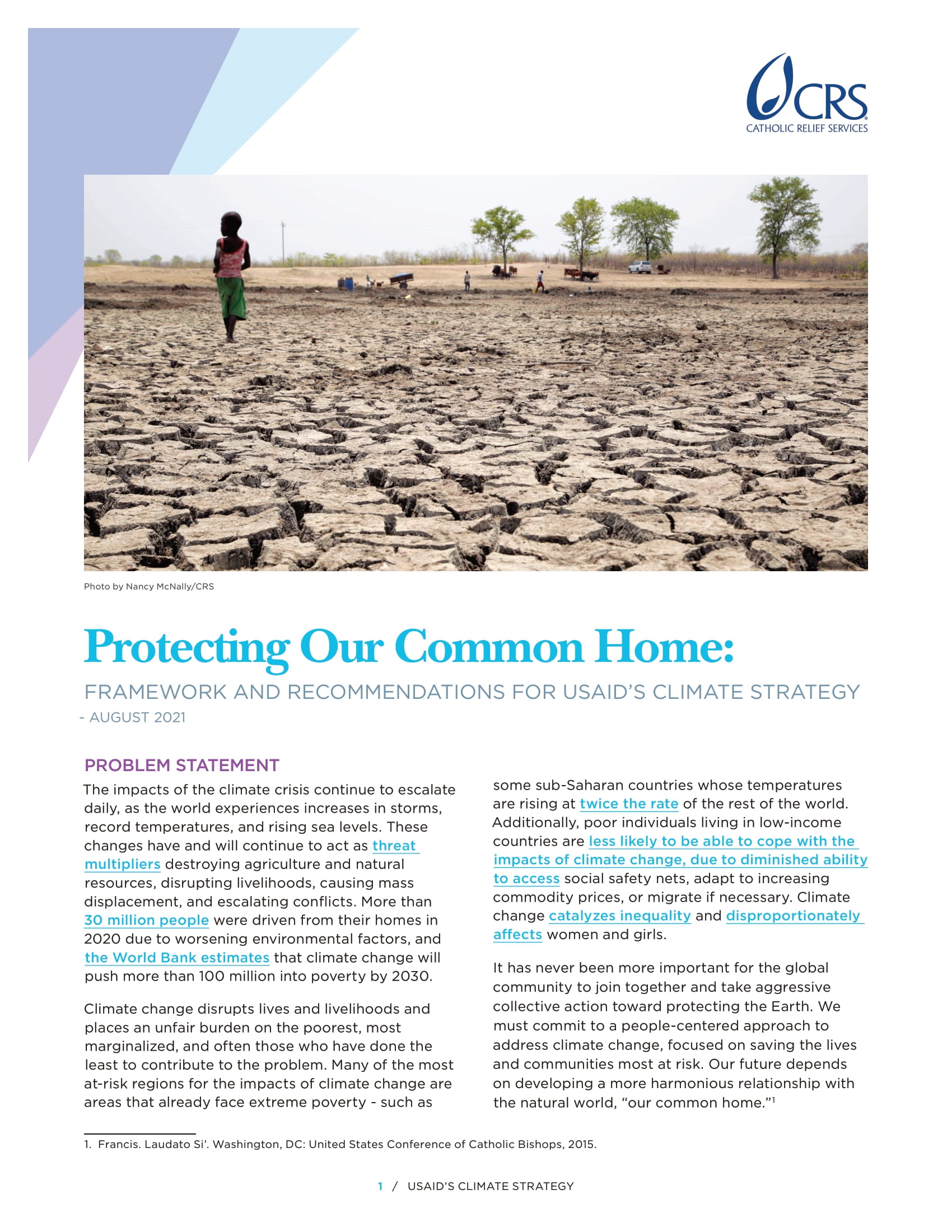
Protecting Our Common Home: Framework and Recommendations for USAID’s Climate Strategy
Background
The impacts of the climate crisis continue to escalate daily, as the world experiences increases in storms, record temperatures, and rising sea levels. These changes have and will continue to act as threat multipliers destroying agriculture and natural resources, disrupting livelihoods, causing mass displacement, and escalating conflicts. More than 30 million people were driven from their homes in 2020 due to worsening environmental factors, and the World Bank estimates that climate change will push more than 100 million into poverty by 2030. Climate change disrupts lives and livelihoods and places an unfair burden on the poorest, most marginalized, and often those who have done the least to contribute to the problem. It has never been more important for the global community to join together and take aggressive collective action toward protecting the Earth. We must commit to a people-centered approach to address climate change, focused on saving the lives and communities most at risk. Our future depends on developing a more harmonious relationship with the natural world, “our common home."
As USAID drafts and evaluates its new climate policy, it is essential that the needs of the most vulnerable communities are put front and center.Based on CRS’ rich history of implementing climate programming, we provide the following best practices and recommendations to USAID for consideration in shaping an effective and sustainable policy for the future.
USAID must develop and prioritize climate strategies that are localized, sustainable, holistic, robustly funded, innovative and data-driven.
A localized climate approach will enable local communities to lead climate adaptation and influence mitigation approaches, putting lived experience at the center of the approach.
- Build from a foundation of existing local knowledge, policies, plans and structures, and contribute USAID’s value proposition through capital and funding, technical assistance and/or coordination.
- Promote USAID’s role in helping link experience at the subnational level to national law and policy, and vice versa.
- Advance localization of climate policy by centering local community groups as possible conveners and connecters.
A sustainable climate approach will invest in programming with a goal of longevity and the intention that the local community will continue to resource, plan, and implement the activities long after USAID funding and staff have left the area.
- Pair short-term success with long-term impacts.
- Address the root causes of the climate-induced disaster itself.
- Elevate the environmental impact and conservation angle of USAID’s work.
A holistic approach should consider and account for the whole person and community being affected by climate change, in addition to the environmental impacts.
- Incorporate governance, peacebuilding and social cohesion elements into all projects, rather than exist as stand-alone activities.
- Understand the role of social and behavior change in climate work.
A robustly funded approach will ensure that local actors have access to sufficient, flexible, and timely funding to implement climate interventions.
- Meet global adaptation funding commitments and ensure increases in climate finance do not come at the expense of existing investments in poverty reducing development.
- Utilize available financing mechanisms as early and effectively as possible.
An innovative and data-driven approach will create a culture of forward-leaning and evidence-based decision making at all levels of climate policy development and implementation.
- Structure the strategy to drive innovation and adapt existing interventions to be as effective for the context as possible.
- Invest in developing evidence-based data banks, tools, and infrastructure in priority countries, which can be utilized in creating and implementing climate policy and programs.
- Design effective and agile assessment and monitoring and evaluation tools.
Updated August 2021


